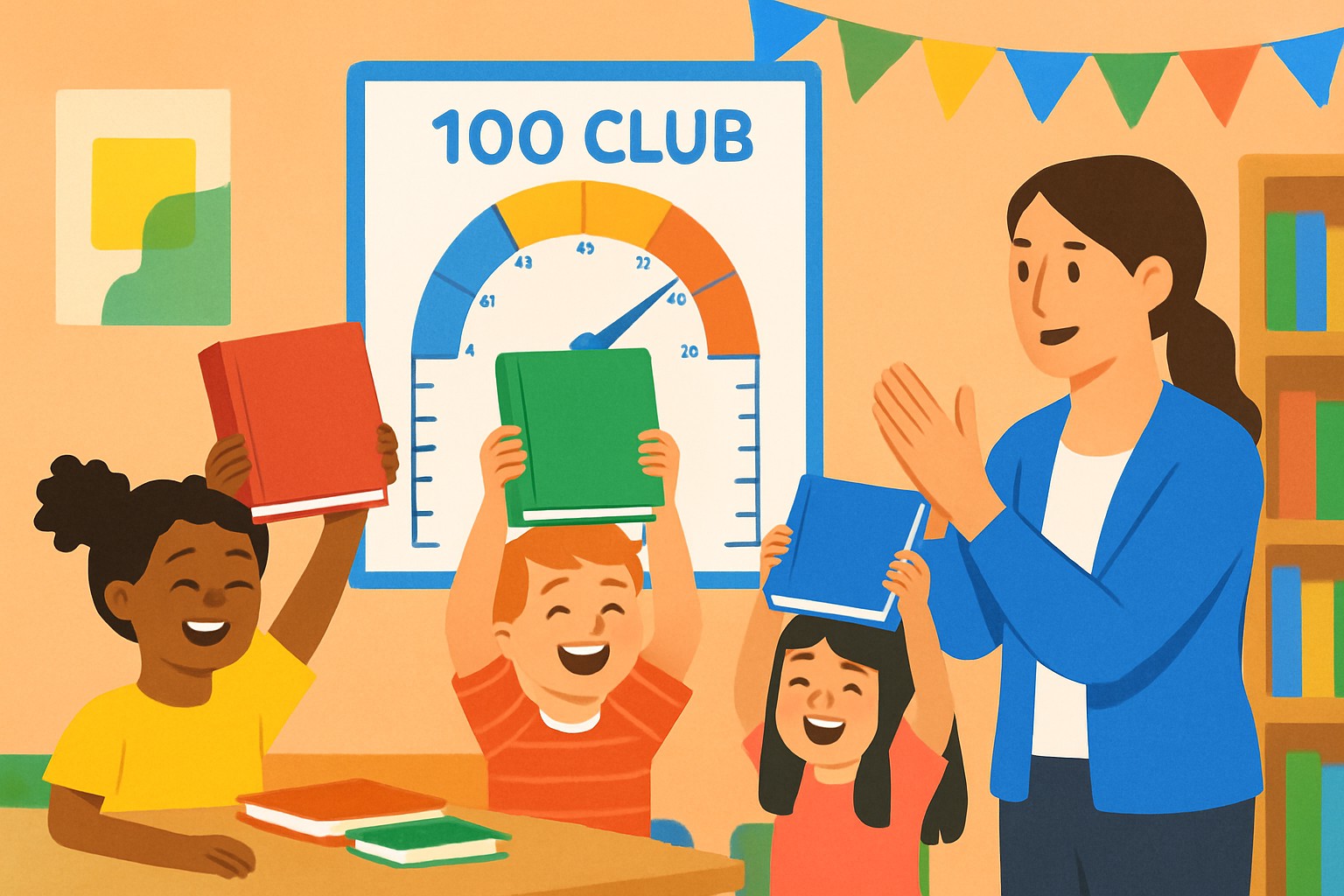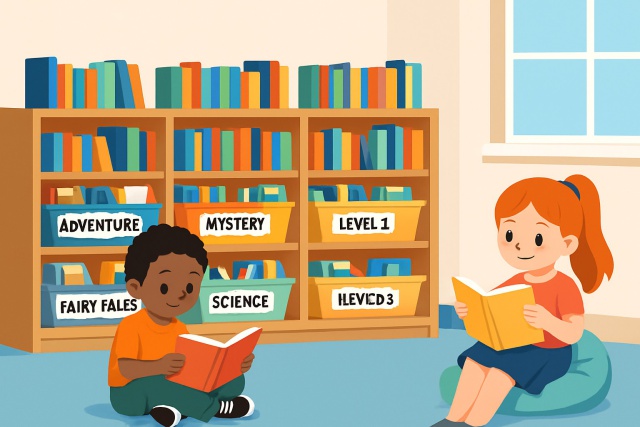What Is the 100 Club? Reading Challenge for Kids

Reading challenges like the 100 Club have become a go-to favorite in classrooms, but many wonder what is the 100 Club exactly. It's a program that boosts kids' literacy and keeps their passion for reading alive through fun, goal-oriented activities that not only encourage regular reading habits but also help deepen kids' comprehension.
What Exactly Is the 100 Club and What Does It Stand For?
The 100 Club is a reading challenge designed with kids in mind, encouraging them to dive into 100 books or rack up 100 reading milestones. It’s a simple yet surprisingly effective way to help young readers build a solid habit of reading regularly.
- The challenge usually invites participants to dive into 100 books or wrap up 100 reading sessions—plenty of pages to keep the brain busy.
- Books come in all shapes and sizes from picture books to chapter books or ebooks and most of these are happily accepted.
- It’s mainly geared toward primary and elementary school kids but with a little tweaking older readers can definitely join the fun.
- Participation can be solo or in a group. Eligibility often hinges on age or reading level so everyone gets a fair shake.
The 100 Club got its start in libraries and schools as a clever way to nudge kids into picking up books every day. It took off in the early 2000s across English-speaking countries where teachers noticed that setting clear and achievable goals was a surefire way to get students reading more consistently.
How the 100 Club Reading Challenge Rolls Along
The 100 Club challenge usually kicks off with a no-nonsense introduction to the students, clearly laying out the goals and what’s expected of them. Teachers pitch in with handy tools to help kids keep tabs on their progress and celebrate those little victories along the way.
Lay out the challenge to the class by clearly explaining the goal of completing 100 books or reading sessions. Make it sound exciting rather than daunting.
Help students set realistic and personalized reading goals that keep their motivation buzzing instead of fizzling out.
Provide reading logs or digital tools so students can keep a neat record of their books and track their progress.
Check progress regularly through colorful charts or lively reading groups to keep the spark of excitement alive.
Celebrate every achievement with certificates, awards or fun classroom events when milestones are reached because recognition motivates.
Teachers often jazz things up with colorful reading logs and progress charts proudly displayed in classrooms. They also hand out certificates to celebrate milestones like 25, 50 or 100 books. These little tokens of achievement seem to really light up the kids' faces.
Why the 100 Club Can Be a Real Win for Kids
The 100 Club does a lot more than just get kids to crack open more books. It also lends a hand with important literacy skills like reading fluency and building a richer vocabulary. Meanwhile, it cleverly fosters positive reading habits by giving kids genuine incentives and a bit of social cheerleading to keep them motivated
- It gives literacy a nice boost by nudging readers to practice regularly which gradually builds stronger reading fluency.
- Reading frequently usually works wonders for expanding vocabulary and sharpening comprehension and honing critical thinking skills.
- This challenge gently nudges people into steady reading habits and weaves reading smoothly into everyday life.
- Kids often beam with pride and feel a genuine sense of accomplishment as they watch their progress over time.
- It sparks a real love for books by opening the door to a mix of genres and stories keeping things fresh and exciting.
"Ever since we kicked off the 100 Club, even the kids who used to drag their feet about reading have genuinely caught the bug and are actually excited to share how far they have come. It’s amazing how much it lightens the classroom vibe and sparks a real, lasting love for learning." – Emma Johnson, Elementary School Teacher
Tips for Teachers to Effectively Implement the 100 Club (Without Losing Your Mind)
Getting the 100 Club up and running smoothly really hinges on clear communication and creative motivation strategies. It also depends on bringing the whole school community on board.
- Clearly lay out the rules and objectives so every student knows what is expected, leaving no room for guesswork.
- Use bright visual tools like charts or sticker boards to keep progress clear and fun. It’s amazing how a splash of color can turn tracking into a mini celebration.
- Recognize milestones during assemblies or class meetings to cheer on achievers and spark motivation in others. Those little pats on the back really count.
- Encourage a variety of reading materials such as fiction, nonfiction, comics and poetry to cater to different tastes and keep things fresh because one size rarely fits all.
- Involve parents by keeping them in the loop with progress updates and offering ideas to support reading at home since teamwork makes the dream work.
To meet a range of reading levels, teachers often set tiered goals—think 50 books for beginners and 100 for the fluent readers who practically devour pages. Sometimes, they mix it up by swapping the number of books for total reading time or pages completed instead. This kind of tailoring goes a long way in helping each student feel like they’ve truly accomplished something, keeping frustration and boredom at bay.
Typical Challenges and a Few Tried-and-True Ways to Tackle Them
The 100 Club usually works like a charm though teachers every now and then hit some bumps like students zoning out or having a hard time keeping tabs on their progress.
- Students often hit a wall and feel burnt out when they race through their reading or try to keep pace under pressure.
- When access to a variety of reading materials is limited, interest can fizzle out.
- Sloppy or inconsistent record-keeping usually sparks frustration, sometimes even leading to heated disagreements.
- Because reading speeds vary widely, setting uniform goals can come off as downright unfair to some kids.
- Families who are not tuned in or aware of the challenge often end up offering less support at home, which doesn’t help matters.
Teachers often suggest taking well-timed breaks and focusing on the pure enjoyment of reading instead of racing through pages. Rotating books regularly helps keep the experience fresh and far from stale. On the tech side, digital apps that parents can easily access do a pretty neat job of keeping records accurate and up-to-date. Setting flexible goals tailored to each student's reading speed goes a long way in sidestepping frustration.
A Quick Look at Various Versions and Adaptations of the 100 Club
Schools and libraries often tweak the 100 Club to better suit their unique student groups and what resources they have on hand. These little adjustments go a long way in keeping students genuinely interested.
- Some schools keep tabs on progress by the total pages read instead of just counting books. It is a neat way to see the true reading effort.
- Group goals really get the teamwork going with entire classes teaming up to hit the 100-book mark or surpass it. Nothing like a bit of friendly competition to boost spirits.
- Themed reading months—think mystery or fantasy—add an extra spark of excitement to monthly targets and make the challenge feel like an adventure.
- Digital tracking apps have made life easier for students and teachers, letting everyone log their reading and keep an eye on progress in real time without breaking a sweat.
- For those who just can’t get enough, reward levels beyond 100 books give super readers something to aim for and keep the motivation alive and kicking.
| Type of Adaptation | Description | Benefits | Ideal Age Group |
|---|---|---|---|
| Pages Read Challenge | Tallies up the total number of pages read instead of just books | Gently nudges readers to dive into longer stretches of reading | Elementary to Middle School |
| Group Reading Goals | Teams up groups or entire classes to hit shared reading milestones | Fosters teamwork and adds a social spark to motivation | All ages |
| Themed Reading Months | Shines a spotlight on specific genres or themes each month | Keeps things fresh and the pages turning with variety | Elementary to High School |
| Digital Tracking Apps | Leverages handy apps to log and monitor reading progress | Takes the hassle out of tracking and supports learning from anywhere | All ages |
| Extended Reward Tiers | Introduces extra milestones beyond the initial 100 books | Gives seasoned readers that little extra push to keep going strong | Middle and High School |
Clever Ways Parents Can Pitch In and Support the 100 Club Reading Challenge at Home
Parents play a key role in helping their child understand what is the 100 Club and shine in it by fostering a warm and positive reading vibe at home.
- Set aside a special time each day when the whole family dives into their books together. It is a great way to lead by example and show good reading habits.
- Make sure your home is stocked with plenty of books that really match your child's interests and reading level. After all, it’s easier to get hooked if the story speaks to you.
- Cheer on those reading milestones with genuine praise or little rewards because a sprinkle of encouragement can go a long way.
- Share your own reading adventures and chat about books to light that spark of curiosity. Sometimes hearing about a favorite story is the best invitation to read.
- Stay in the loop by keeping regular contact with your child’s teacher to track progress and get some great book recommendations. Teamwork makes the dream work.






